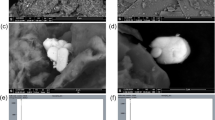Abstract
Bentonite clay is the most popular binder for iron ore concentrate pellets. To minimize bentonite cost and to reduce the amount of silica that it contributes to the finished pellet, the industry needs to minimize bentonite dosage by maximizing its effectiveness as a binder. However, the behavior of any given bentonite in iron ore pelletization has proven to be impossible to predict accurately. Therefore, each bentonite must be evaluated by trial-and-error tests. In this paper it is shown that the reason bentonite behavior was impossible to predict is that the moisture in the iron ore concentrate can have much higher levels of dissolved cations than had previously been realized. In one operating plant, the moisture in the magnetite concentrate had levels of Ca+2 and Mg+2 that were 500 times higher than had been expected from analyses of the plant recycle water. These cations are known to strongly impact the binding effectiveness of bentonites. Seven bentonites were studied to determine the effects of concentrate moisture chemistry on the ability of the bentonites to produce iron ore concentrate pellets with satisfactory wet knock and wet and dry compressive strengths. When iron ore concentrate from an operating plant was flushed with distilled water to remove the dissolved cations before it was mixed with each of the bentonites and pelletized, the pellet properties improved. When the cations were removed, the wet knock values increased an average of 92% and the dry compressive strength increased an average of 46%. The bentonites were not all equally affected by the cations in the water — some of the bentonites were strongly affected by the water chemistry, while others were only slightly affected.
Similar content being viewed by others
References
ASTM E382-97, 1998, “Standard test method for determination of the crushing strength of iron ore pellets,” 1996 Book of ASTM Standards, Vol. 3.06, pp. 57–58 (Metals Test Methods and Analytical Procedures).
ASTM E946-92, 1996, “Standard test method for water absorption of bentonite by the porous plate method,” Annual Book of ASTM Standards, Vol. 3.06, pp. 276–277 (Metals Test Methods and Analytical Procedures).
Bleifuss, R.L., 1999, “Bentonite Survey, Iron Ore Cooperative Research Committee Report,” Colerain Minerals Research Laboratory, Natural Resources Research Institute, Project #5697116 October 20, 49 pp.
CCI-CMSC, 1994, “Empire Laboratory Green Ball Tests Evaluating the Effect of Wash Water On Bentonite Performance with Viceroy Concentrate,” Cleveland-Cliffs Inc. (CCI) - Cliffs Mining Services Company (CMSC), Memorandum No. 5453, March 31, 10 pp.
Dixon, W.J., and Massey, F.J., 1983, Introduction to Statistical Analysis, 4th Ed., McGraw-Hill, New York, NY, pp. 83–84, and Table A5.
Elzea, J., and Murray, H.H., 1994, “Bentonite,” Industrial Minerals and Rocks, D.D. Carr, ed., Society for Mining, Metallurgy, and Exploration, Inc., pp. 223–246
Engesser, J., 2000a, “The effect of water chemistry on pre-fired pellet quality,” Presentation at Michigan Technological University, January 30.
Engesser, J., 2000b, “Bentonite Quality - The Effect of Water Chemistry and Antifreeze Agents on Bentonite Binder Characteristics,” Colerain Minerals Research Laboratory, Project #5600108, October 17.
Fuerstenau, D.W., and Clark, S.W., 1981, “Interpretation of the role of montmorillonite in the pelletizing of iron ore concentrates,” Preprints of the Third International Symposium on Agglomeration, Nurnberg, May 6–8.
Grim, R.E., 1968, Clay Mineralogy, 2nd Ed., McGraw-Hill, New York, p.79.
Kawatra, S.K. and Ripke, S.J., 2001, “Developing and Understanding the Bentonite Fiber Bonding Mechanism,” Minerals Engineering, Elsevier Science Ltd., Vol. 14, No. 6, pp. 647–659.
Kawatra, S.K., and Ripke, S.J., 2002, “Effects of bentonite fiber formation in iron ore pelletization,” International Journal of Mineral Processing, Elsevier Press, Amsterdam.
Railey, R., 2001, Personal communication, Chemical Engineer, CMSC Research Lab.
Reisch, F.J., 2000, Personal communication, Manager of Minerals Development, American Colloid Co.
Rice, D.A. and Stone, R.L., 1972, “Influence of plant water chemistry on the strength of unfired pellets,” SME/AIME Trans., Vol. 252, March, pp. 1–6.
Ripke, S.J., and Kawatra, S.K., 2000a, “Can fly-ash extend bentonite binderfor iron ore agglomeration?” International Journal of Mineral Processing, Elsevier Press, December, Vol. 60, pp. 181–198.
Ripke, S.J. and Kawatra, S.K., 2000b, “Iron ore pellet binding mechanisms pozzolanic vs. physical binders,” Proceedings of the XXI Int. Mineral Proc. Congress, Rome, Italy, July 23–27, Elsevier Press, pp. A4 120–127.
Ripke, S.J., and Kawatra, S.K., 2000c, “Fibrous bonding mechanisms for reducing bentonite dosage,” American Foundry Society Transactions, Vol. 108, pp. 101–104.
Smiernow, G.A., Doheny, E.L., and Kay, J.G., 1980, “Bonding mechanisms in sand aggregates,” American Foundry Society Transactions, Proceedings of the 84th annual meeting, April 21–25, pp. 659–682.
White, W.A., and Pichler, E., 1959, “Water Sorption Characteristics of Clay Minerals,” Illinois State Geological Survey, Circular, pp. 266.
Wilson, J.M.D., 1980, “The role of Binders in Iron Ore Pelletizing — A Review,” Canada Centre for Mineral and Energy Technology, Mineral Sciences Laboratories Division Report MRP/MSL 80-52 (OP&J), December, 40 pp.
Author information
Authors and Affiliations
Additional information
Nonmeeting paper number 02-313. Original manuscript submitted tor review April 2002. Discussion ot this peer-reviewed and approved paper is invited and must be submitted to SME Publications Dept. prior to Feb. 29, 2004.
Rights and permissions
About this article
Cite this article
Ripke, S.J., Kawatra, S.K. Effect of cations on unfired magnetite pellet strength. Mining, Metallurgy & Exploration 20, 153–159 (2003). https://doi.org/10.1007/BF03403148
Received:
Revised:
Accepted:
Published:
Issue Date:
DOI: https://doi.org/10.1007/BF03403148




